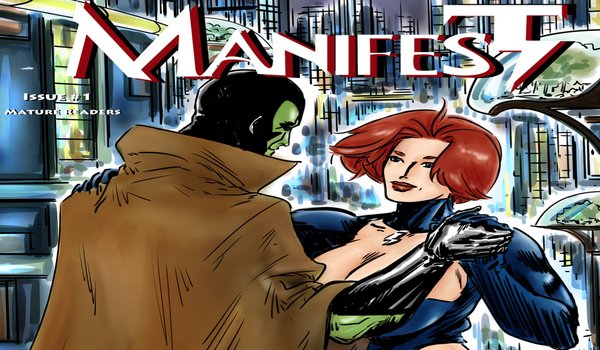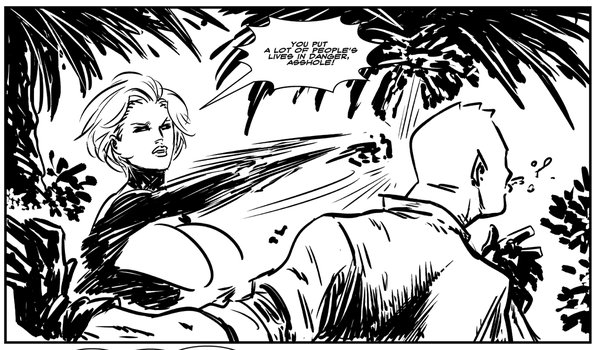Comic books are an expansive, genre-defying medium. Though they are most well-known for stories focused on superheroes, comics have also incorporated elements from science-fiction, horror, comedy, and countless other genres. Manifest, both written and illustrated by Riccardo Desini, is an overzealous work that attempts to include aspects from many of the aforementioned genres.
While not entirely a superhero story, Manifest depicts an unearthly world, inhabited by both human and alien alike, as an unruly dictator is confronted by a band of rebel super-powered soldiers, one of whom just so happens to be his adopted daughter. The story is even more complicated than it may initially sound; right from the first page, the characters have to contend with alternate dimensions, psychic projections of their past selves, and other similar sci-fi tropes. Though Desini is quite ambitious in his scope for the world of Manifest, his vision of that world is never as clear as it it in his mind. The book’s unclear identity is not helped by the overwrought storytelling and artwork that can, at times, be confusing.
The first of the 6-issue arc, “The Noise of Thunder,” opens as the voluptuous Thunder Girl is rescued from a mental prison by the Wayfarer, an android-like being who has the psychic ability to enter the minds of others. We soon learn that Thunder Girl, or Tessa Theus, had been put in a comatose-state by Saturn, her adoptive father, in which she remained for two years. During this time, Tessa’s mental self had been living in a earthly, material existence much like the first act of The Matrix. When The Wayfarer is able to wake up Tessa, she’s once again returned to the comparatively more hi-tech world of Manifest, yet without her powers, and without the memories of who she used to be. From here, the two partners embark on a journey to reclaim Tessa’s powers, confront Saturn, and save the people of Manifest. Although the series introduction isn’t too complicated, especially for those whom are familiar with similar science-fiction stories, the exposition is provided in long-winded word bubbles that hit the reader over the head with information. Much of the first three issues could have benefited from editing and a more streamlined narrative.
If there’s another problem that is bound to annoy readers, it undoubtedly has to do with Thunder Girl’s figure and wardrobe choices. Not only is the character scantily clad, but what little of an outfit she does have barely covers her monstrous breasts. There are several instances in which other characters comment on Thunder Girl’s appearance in a sexual light, by either mocking or ogling her. If that wasn’t already off-putting, Thunder Girl herself, after first regaining her memories, is baffled by her outfit and calls it “ridiculous and slutty.” There’s an implication here that the comic is attempting to subvert the gratuitousness of female nudity, by drawing attention to Thunder Girl’s abhorrence by her own costume – which, of course, would have been an interesting addition to the story. The opportunity, however, is quickly forsaken when Tessa immediately adds, “Look at my butt. I’m kinda hot.” Manifest‘s depiction of its female characters, of which there are no shortage, certainly leaves a lot to be desired.
The artwork in Manifest is something that surely separates it from the rest. Though illustrated in black-and-white, the sketch-like quality offers the comic a unique quality, almost as if it’s a work-in-progress. It may certainly have benefited from the use of colors – especially in regard to some of the more outlandish characters – however, there are still some really cool scenes visualized here by the clearly talented artist.
The storyline could have used some tinkering, as well. It’s never entirely clear what exactly the conflict is and what exactly the villain, Saturn, is trying to do. The reader is essentially told which are the good guys and which are the bad guys – and even then it’s a bit difficult to gather who’s on which side – followed by schemes and skirmishes. There’s an apparent lack of action in the first issue, yet the fighting does pick up in the second and third issues. Also, it should be noted that there are a number of awkwardly phrased lines of dialogue, in addition to several typos; however, because Desini is from Italy, it’s noteworthy that he’s able to pull off some of the more complex explanations of the sci-fi elements without more difficulty.
For ardent fans of sci-fi superhero stories, there’s some aspects of Manifest that will surely hold their attention. For those looking for a more straightforward superhero comic, there may be too much explaining and not enough action to keep them interested. With much of the backstory revealed and the characters established, I’m hopeful that the next three issues keep the ball rolling and the series as a whole improves.
If you’re interested in purchasing the comic, you can do so here.
What did you think? Does Manifest have the potential to be a great series? Is the depiction of Thunder Girl as much of a problem as I thought it was? Sound off in the comments or send us your thoughts on Twitter!



